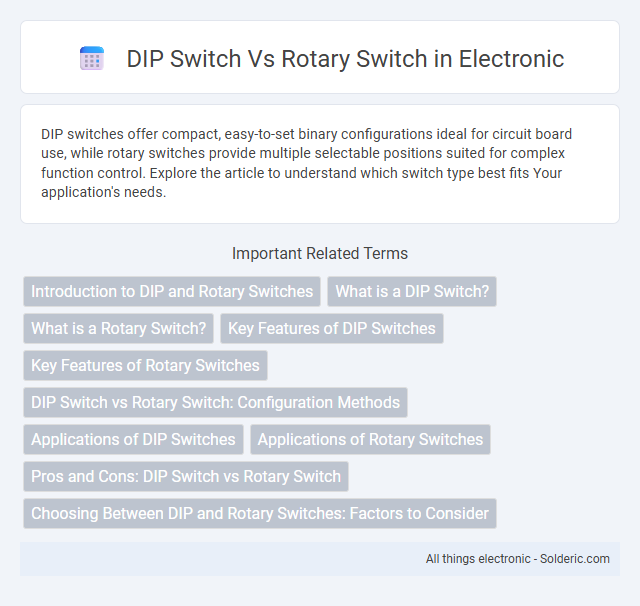DIP switches offer compact, easy-to-set binary configurations ideal for circuit board use, while rotary switches provide multiple selectable positions suited for complex function control. Explore the article to understand which switch type best fits Your application's needs.
Comparison Table
| Feature | DIP Switch | Rotary Switch |
|---|---|---|
| Function | Manual binary input selection | Multi-position mechanical switching |
| Positions | Typically 2 (ON/OFF) per switch | Multiple positions, often from 2 to 12+ |
| Size | Compact, small footprint | Generally larger due to rotating mechanism |
| Installation | Soldered directly on PCB or socketed | Panel or PCB mounted with rotary shaft access |
| Application | Setting device configurations, addressing | Selecting modes, input channels, or ranges |
| Durability | Limited mechanical life | Higher mechanical endurance |
| Operation | Slide toggles for ON/OFF | Rotating knob or lever |
| Cost | Generally low cost | Moderate cost due to complexity |
Introduction to DIP and Rotary Switches
DIP switches are compact, manual electric switches typically used for setting configurations on printed circuit boards, featuring multiple small toggles in a single package. Rotary switches provide multiple positions through a rotating lever, allowing selection among various circuits or functions in a compact form factor. Your choice between DIP and rotary switches depends on the required number of circuits, ease of adjustment, and application space constraints.
What is a DIP Switch?
A DIP switch is a compact, manual electric switch packaged in a group of small toggle switches, designed to configure hardware settings in electronic devices. It allows individual on/off control through a binary system, commonly used in computer motherboards, industrial controls, and communication devices for setting operational parameters. DIP switches offer reliable, low-cost, and easy-to-use solutions for customizing device functions without requiring software input.
What is a Rotary Switch?
A rotary switch is an electromechanical device that allows users to select one of several electrical circuits by rotating a knob or shaft. It is typically used in applications requiring multiple positions or settings, such as audio equipment, instrumentation, and control panels. Compared to DIP switches, rotary switches offer more position options and easier manual selection for circuit control.
Key Features of DIP Switches
DIP switches feature a compact design with multiple individual switches integrated into a single package, allowing for easy binary on/off configurations ideal for circuit customization and settings selection. They offer reliable, low-voltage signal control with stable mechanical contacts that resist vibrations and ensure consistent performance in embedded systems. DIP switches are highly valued for their simplicity, low cost, and straightforward installation, making them a preferred choice for setting hardware parameters without the need for software intervention.
Key Features of Rotary Switches
Rotary switches offer multiple fixed positions, enabling precise control over circuit selection in complex electronic applications. They provide high durability and reliable mechanical operation, often rated for tens of thousands of cycles. Their compact design supports a wide range of pole and throw configurations, making them ideal for multi-circuit control environments.
DIP Switch vs Rotary Switch: Configuration Methods
DIP switches use small toggle switches arranged in a dual inline package, allowing for simple binary configuration by setting each switch to an on or off position, ideal for compact and fixed settings. Rotary switches provide multiple selectable positions via a rotating knob or actuator, enabling more complex or variable configurations with ease of use and clear tactile feedback. Your choice between DIP and rotary switches depends on the required precision, space constraints, and ease of manual adjustment for your application.
Applications of DIP Switches
DIP switches are commonly used in electronic devices for setting configurations, such as selecting device modes, enabling or disabling features, and setting hardware addresses. Their compact design makes them ideal for circuit boards in consumer electronics, industrial controls, and telecommunications equipment. You can rely on DIP switches for precise, reliable manual input in embedded systems and programmable devices.
Applications of Rotary Switches
Rotary switches are widely used in applications requiring the selection of multiple circuits or settings, such as audio equipment, industrial machinery, and control panels. Their design allows for easy switching between different operational modes or signal paths, making them ideal for complex electronic devices and telecommunications systems. You can find rotary switches in products that demand precise control and reliable position retention in diverse environments.
Pros and Cons: DIP Switch vs Rotary Switch
DIP switches offer compact size and ease of use with multiple binary settings, making them ideal for circuit configuration and low-profile applications, but they can be less intuitive and harder to adjust frequently compared to rotary switches. Rotary switches provide a clear visual indication of the selected position and accommodate a wider range of settings with simple rotation, though they tend to be larger and more prone to mechanical wear over time. Choosing between DIP and rotary switches depends on factors like space constraints, frequency of adjustment, and the need for precise position indication.
Choosing Between DIP and Rotary Switches: Factors to Consider
When choosing between DIP switches and rotary switches, consider factors such as space constraints, switching needs, and ease of use, with DIP switches offering compact, binary selection ideal for configuration settings, while rotary switches provide multiple position options suitable for varied signal routing. Electrical specifications, including voltage and current ratings, play a critical role in determining the best switch type for a given application. Environmental factors like vibration and temperature exposure should also influence the decision, as rotary switches typically offer more robust mechanical resilience compared to DIP switches.
DIP switch vs rotary switch Infographic

 solderic.com
solderic.com